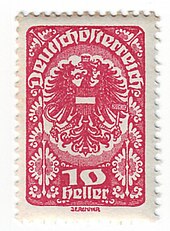Proclamation of the Republic of German Austria
The Republic of German Austria was proclaimed on November 12, 1918 by two of the three presidents of the Provisional National Assembly , Franz Dinghofer and Karl Seitz , in front of the parliament building in Vienna .
For this day, a Tuesday, work rest was ordered in Austria and the population was called on to participate in the proclamation. Despite the cold and damp weather, around 150,000 people gathered in front of Parliament. Among them was a group of Floridsdorf workers who carried a banner with the inscription "High the Socialist Republic" with them. Two companies of the Viennese “ Red Guards ” moved out of the collegiate barracks , at their head the former kuk Oberleutnant and now journalist Egon Erwin Kisch and as commander of the second company the platoon leader Robert Lindner. Despite the express prohibition, they carried cartridges with them in their coat pockets. A company returning home, the Deutschmeister Volkswehr battalion and a group from Ottakring also marched on. Police were not present. Their task had been handed over to the People's Army organized by Julius Deutsch .
After the third reading and unanimous approval of the “Law on the State and Government Form of German Austria ”, shortly before 4 pm, the presidents of parliament, members of the government and members of the National Assembly appeared in a solemn procession at the balustrade in front of the portico of the parliament. President Dinghofer began to read out the text of the new constitution, with two parliamentarians on the right and left slowly wanting to raise red-white-red flags. Now Red Guards from the Kisch group stormed forward, tore the white middle section out of the flags and pulled up the rest of the red flags. Afterwards, State Chancellor Karl Renner and President of the National Assembly Karl Seitz spoke , and at 4:30 p.m. the members of parliament took their seats again.
A few groups discussed in front of parliament, with Karl Steinhardt , the man behind the workers' councils of Wiener Neustadt and co-founder of the Austrian Communist Party , being the spokesman. He had a counter manifesto in hand and called for the establishment of a soviet republic . He took the applause of the bystanders as approval and tried to penetrate the parliament at the head of a troop of armed men in order to convey to the State Council the demand for the immediate establishment of a socialist republic. He was stopped by Julius Deutsch and social democratic officials.
Next, an army group led by an officer with drawn saber and felled bayonets charged against the Red Guards. The parliament gate was closed. Now a shot was fired and the Red Guards fired at the parliament and the pillars. Ludwig Brügel , head of the state chancellery's press office and writer , was injured in the head. A man and a child were trampled to death by the fleeing crowd, and there were several seriously injured and many slightly injured. Around 5:15 p.m. the tumult subsided.
Shortly afterwards, 150 Red Guards, headed by Egon Erwin Kisch, occupied the editorial team of the Vienna daily Neue Freie Presse and forced the printing of a special issue about the proclamation of the socialist republic. At 8 p.m., a second leaflet was forced to justify the occupation of the Neue Freie Presse. Attempts to proclaim the socialist republic in front of parliament and in the media were in vain. They weren't even supported by the Social Democrats.
The day of the proclamation of the republic was declared a national holiday in 1919 and remained so in the authoritarian corporate state until it was abolished .
Richard Hauffe's picture of the crowd in front of Parliament, taken from Palais Epstein , became the best-known representation of the proclamation of the Republic.
literature
- Karl Glaubauf : The People's Army from 1918-20 and the establishment of the republic. Stöhr-Verlag, Vienna 1993 (published on the occasion of the 75th anniversary of the founding of the republic).
- Karl Glaubauf: The Vienna People's Army 1918–1920 and the founding of the republic (essay). Austria Forum , 2010.
Individual evidence
- ^ Jacques Hannak: Karl Renner and his time. Attempt a biography. Europa Verlag, Vienna 1965, p. 354.
- ^ Stenographic minutes of the 3rd session of the Provisional National Assembly for German Austria, page 69
- ^ Wiener Allgemeine Zeitung of November 12, 1918, p. 3; Neue Freie Presse of November 13, 1918, p. 3 f.
- ↑ Shots for birth , in: Wilhelm J. Wagner: The large picture atlas for the history of Austria. Kremayr & Scheriau, Vienna 1995, p. 194 f.


